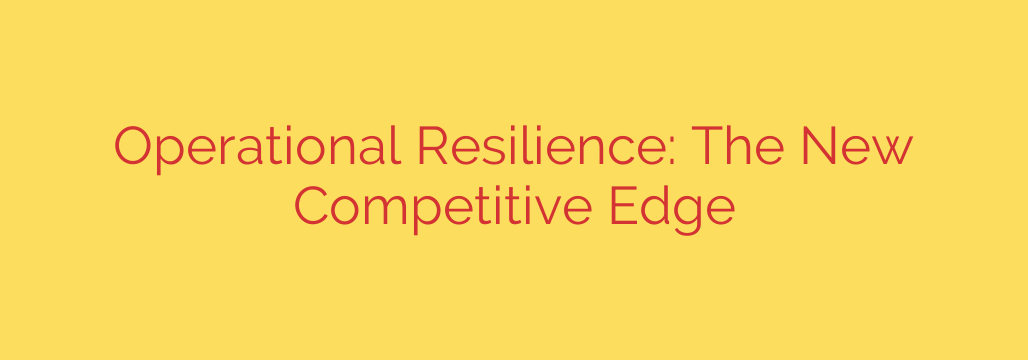
Beyond Disaster Recovery: Why Operational Resilience is Your New Competitive Advantage
In today’s volatile business environment, disruption is no longer an exception—it’s a constant. From sophisticated cyberattacks and supply chain breakdowns to global health crises and extreme weather events, the threats facing organizations are more frequent and complex than ever before. For years, the focus was on disaster recovery—the ability to restore systems after a catastrophic failure. But this reactive approach is no longer enough.
Modern businesses need more than a recovery plan; they need a strategy for continuous operation. This is the core of operational resilience: the ability to prevent, adapt to, respond to, and learn from disruptions to continue delivering critical services. It’s a proactive framework that transforms risk management from a defensive cost center into a powerful competitive edge.
The Proactive Shift: More Than Just Bouncing Back
Traditional disaster recovery and business continuity plans often sit on a shelf, dusted off only when an incident occurs. They are typically IT-focused and designed to answer one question: “How quickly can we get back online after everything has failed?”
Operational resilience asks a fundamentally different set of questions:
- How can we prevent disruptions from happening in the first place?
- When an incident does occur, how can we absorb the impact and continue operating without significant customer-facing consequences?
- What can we learn from every event—big or small—to become stronger and more adaptable?
This shift is crucial. It means not just surviving a disruption, but adapting, responding, and emerging stronger. While disaster recovery is about bouncing back, operational resilience is about moving forward, even under pressure.
The Core Pillars of a Resilient Framework
Building true operational resilience requires a holistic approach that integrates people, processes, and technology across the entire organization. The framework is built on several key pillars.
1. Identify and Map Critical Services
You cannot protect what you don’t understand. The first step is to identify your most important business services—those that, if disrupted, would cause the most harm to your customers, your reputation, and your bottom line. Once identified, you must map every dependency that supports these services, including the specific applications, technology infrastructure, key personnel, and third-party vendors involved.
2. Set Clear Impact Tolerances
For each critical service, you must define its “impact tolerance.” This is the maximum level of disruption a service can withstand before it causes unacceptable harm. This isn’t just a recovery time objective (RTO); it encompasses data loss, financial costs, customer impact, and regulatory breaches. Setting clear tolerances provides a benchmark for all your resilience activities.
3. Build for Protection and Adaptation
With a clear understanding of what matters most, you can design systems to be inherently resilient. This involves:
- Implementing robust cybersecurity controls to prevent attacks.
- Creating redundancy in critical systems and supply chains.
- Adopting modern architectural principles like microservices and cloud infrastructure that allow for graceful degradation instead of total failure.
4. Test, Test, and Test Again
A resilience plan is only as good as its last test. It’s essential to move beyond basic compliance checks and conduct rigorous, realistic testing scenarios. This includes tabletop exercises, red team/blue team simulations, and controlled chaos engineering to see how your systems and teams perform under real-world stress. The goal is to find weaknesses before an attacker or an incident does.
5. Foster a Culture of Resilience
Operational resilience cannot be the sole responsibility of the IT or risk department. It must be embedded in your company culture, from the boardroom to the front lines. This means empowering employees to identify risks, encouraging transparent communication during incidents, and committing to a cycle of continuous learning and improvement after every event.
Actionable Steps to Build Your Resilience Strategy
Turning resilience from a concept into a reality requires deliberate action. Here are a few security and operational tips to get started:
- Secure Executive Buy-In: Frame operational resilience as a strategic business enabler, not just an insurance policy. Highlight its role in protecting revenue, enhancing customer trust, and creating a competitive advantage.
- Conduct a Business Impact Analysis (BIA): This foundational exercise will help you formally identify your critical services and the impact of their potential disruption.
- Prioritize Third-Party Risk Management: Your resilience is linked to that of your suppliers. Scrutinize the security and continuity plans of your critical vendors and ensure your contracts have clear resilience requirements.
- Develop a Coordinated Response Plan: Ensure your incident response plan is integrated across departments—IT, communications, legal, and operations. Everyone should know their role when a disruption occurs.
- Invest in Visibility and Detection: You can’t respond to what you can’t see. Implement advanced monitoring tools that provide real-time visibility into the health of your critical services and can detect anomalies before they escalate.
In the end, operational resilience is more than a set of technical controls or documents. It is an organizational mindset that accepts the reality of disruption and prepares the business not only to withstand it but to thrive because of it. Companies that master this will not only be safer and more stable—they will be the leaders who capture market share while their less-prepared competitors struggle to recover.
Source: https://collabnix.com/why-operational-resilience-is-the-next-competitive-advantage/








